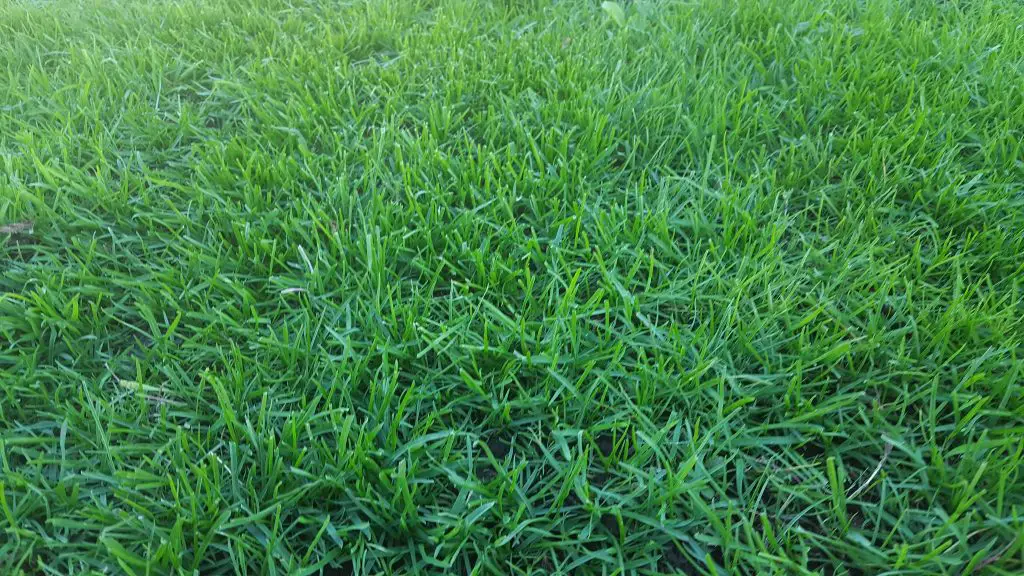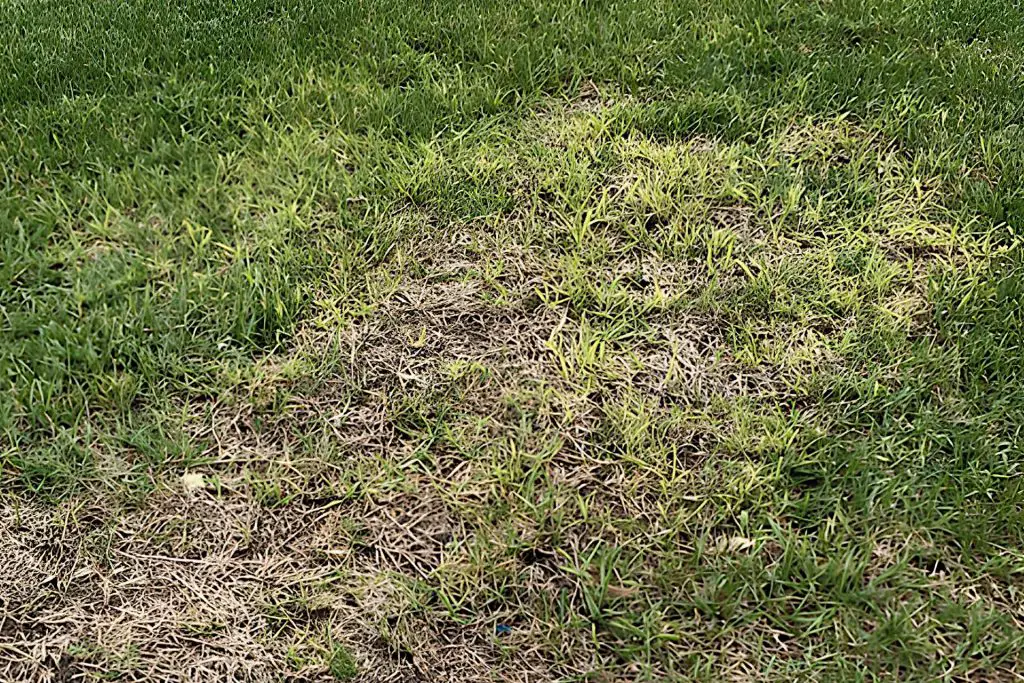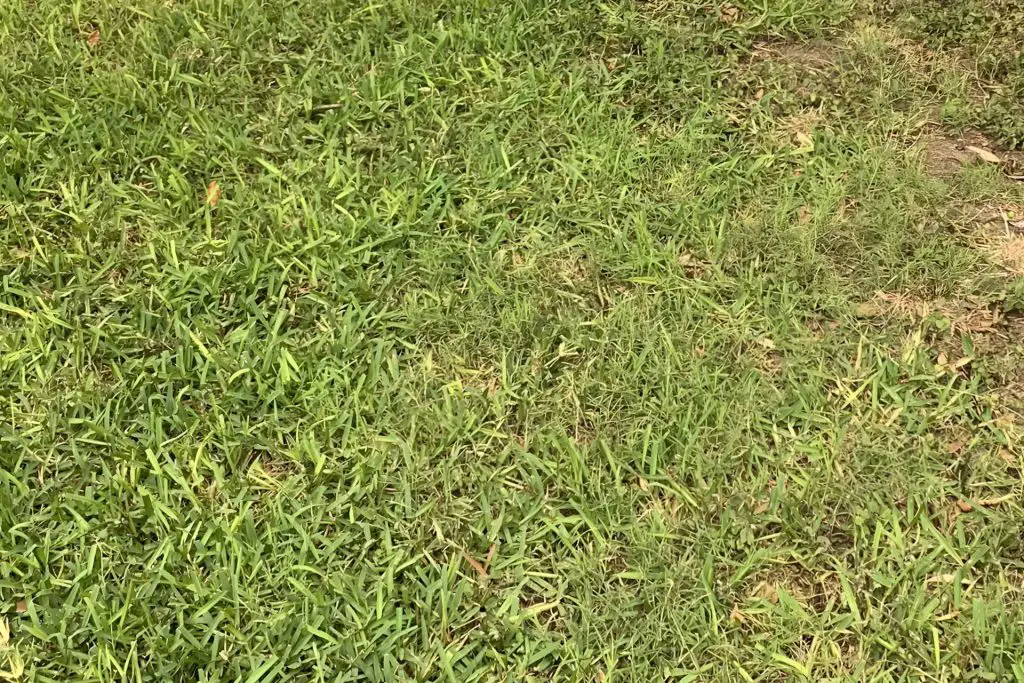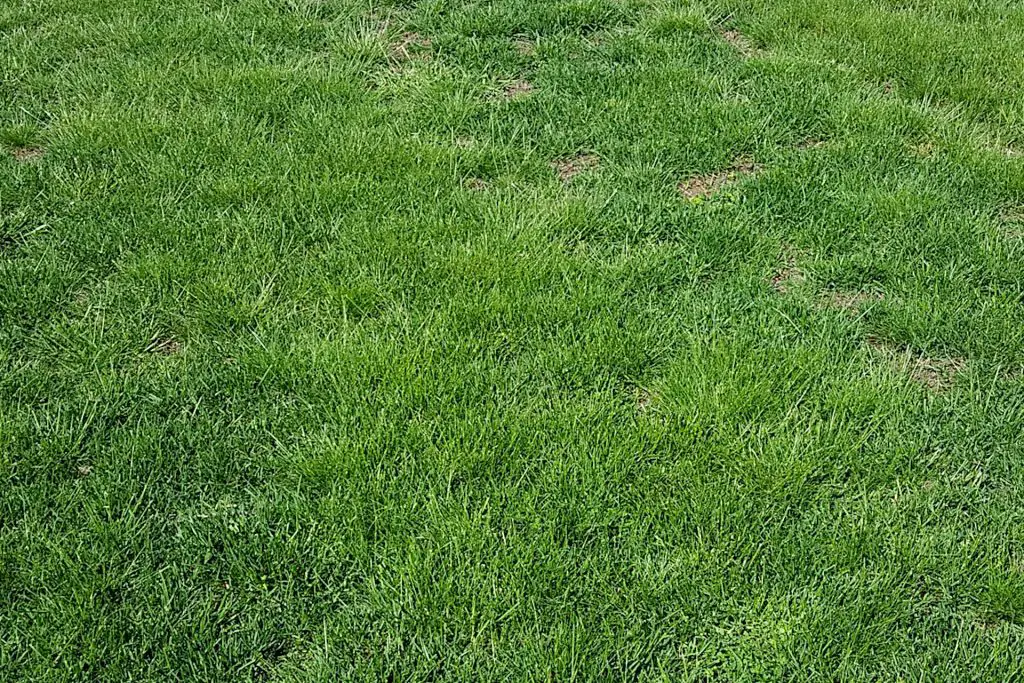Is Your St Augustine Grass Turning Yellow? What are the Causes and Fixes?
- Yellowing in St. Augustine grass can stem from three main causes: fungal diseases, soil nutrient imbalances like iron and nitrogen deficiency, and poor maintenance such as improper watering.
- Early identification of the underlying issue is crucial for straightforward fixes and effective treatment.
- Adopting good maintenance practices can prevent these problems from reoccurring, ensuring a healthy, vibrant lawn.
It can be quite disturbing to see your St Augustine Grass turning yellow as yellow and brown patches start to develop and spread across your lawn. The truth is, is that St. Augustine grass is a relatively high-maintenance grass. It requires regular mowing (about once a week), watering, fertilizing, and pest control to keep it looking a deep beautiful green.
This is because, without good lawn care, it is readily susceptible to thatch buildup and consequently to fungal diseases that cause yellow/brown patches to form on the grass. In addition, poor soil nutrient balance, compaction, and incorrect lawn maintenance procedures are usually the root cause of the yellowing. Below, we will look at the most common causes of the problem and how to fix them.
About St Augustine Grass

St. Augustine grass, scientifically known as Stenotaphrum secundatum is a warm-season grass that is a popular choice for lawns due to its dense, carpetlike sod and its ability to crowd out most weeds and other grasses. It has a high tolerance for wear and tear, making it a good choice for areas that see a lot of foot traffic. It is also salt-tolerant and is therefore often found in coastal areas.
It is a warm-season turfgrass that thrives in tropical and subtropical regions. Originating from the coastal regions of the Gulf of Mexico and the Mediterranean, this grass type has become a popular choice for lawns, especially in the southern United States.
Growth Habits
When it comes to growth habits, St. Augustine grass is known for its dense mat-like structure. It has broad, flat blades and spreads through stolons, which are horizontal stems that grow above ground. This characteristic makes it excellent for crowding out weeds, but it also means that it requires regular mowing to prevent thatch buildup.
Key Growth Habits:
- Mat-like structure: Excellent for weed control
- Broad, flat blades: Provides a lush appearance
- Spreads through stolons: Enables quick lawn coverage
Ideal Soil Conditions
St. Augustine grass is relatively forgiving when it comes to soil types, but it performs best in well-drained, sandy soils with a pH level between 5.0 and 8.5. Soil testing is recommended to determine nutrient levels and pH balance. If your soil is lacking in nutrients, a balanced fertilizer can provide the necessary macro and micronutrients for optimal growth.
Soil Requirements Table
| Soil Type | Ideal pH Range | Nutrient Needs |
|---|---|---|
| Sandy | 5.0 – 8.5 | Balanced Fertilizer |
| Loamy | 5.5 – 7.5 | Nitrogen-rich Fertilizer |
| Clayey | 6.0 – 7.0 | Iron supplements |
Fungal Diseases
Fungal diseases are one of the most common problems that can affect your St Augustine grass. There are many different types of fungi that can cause disease, and they can attack both the roots and the leaves of the grass. The two most common diseases that affect St Augustine grass are Take All Root Rot and Brown Patch. Another fungal infection called gray spot can also be common in areas with extremely high humidity.
Take All Root Rot
Take All root rot is a fungal disease that is caused by the Gaeumannomyces tritici var. graminis pathogen. These fungi attack the roots of the grass, causing them to rot. The leaf blades of the grass will then turn yellow and die. It usually appears in spring, around April and May and is less likely to appear in the heat of summer. Although the fungus can generate spores, it spreads primarily through roots and stolons. This means that general foot traffic or mowing will not typically spread the disease. This disease is most common in wet, humid conditions.
Another important factor is the nature of the soil. You need to relieve any soil compaction and ensure adequate drainage in the substrate as the disease spreads easily in damp turf by aerating at least once or twice a year if you have heavy clay soil. Monitor your watering practices carefully. It is better to water infrequently but deeply than to give the grass frequent, shallow watering.
Brown Patch
Brown Patch is caused by the fungi Rhizoctonia solani and R. cerealis pathogens. These fungi attack the leaves of the grass, causing them to turn brown. The patches of brown grass that develop will then spread, killing more grass in that area. The disease usually affects grass that grows in warm, dry climatic conditions.
The main problem is that brown patch is hard to eradicate, so cultural control and prevention should be incorporated into your lawn care program, especially if your lawn is in climatic conditions conducive to the disease. Understanding the nature of the disease is essential to get rid of brown patch. It is critical to understand that the fungus can live in your soil despite the absence of visible signs of it in the grass.
Gray Leaf Spot
As the name suggests, gray leaf spot is a fungal disease that causes gray or brown lesions on the leaves of Augustine grass. The fungus Pyricularia grisea, also known as Magnaporthe grisea, is the most common cause of the disease, and it thrives in warm, wet conditions.
The fungus thrives in warm, wet conditions, with the disease is most common in the summer months when extended periods of leaf wetness and high humidity create favorable conditions for the fungus to grow. This makes areas such as Florida a hot spot for the disease
Symptoms of gray leaf spot include small, round or rectangular lesions on the leaves of the grass. These lesions can be gray, brown, or black in color, and they are often surrounded by a yellow halo. The lesions can grow and merge together, eventually causing the leaves to turn yellow and die.
Gray leaf spot is most damaging to young, actively growing grass, and it can cause serious problems in new turf or sprigged areas. The disease can also slow the growth of mature turf and damage the blades/leaves of the grass, leading to a loss of vigor and a general thinning as a result.
Preventive Measures for Fungal Diseases in St. Augustine Grass
Fungal diseases can wreak havoc on your St. Augustine grass, but the good news is that prevention is entirely possible. By taking a proactive approach, you can keep your lawn healthy and vibrant throughout the year.
Lawn Maintenance
Regular lawn maintenance is the first line of defense against fungal diseases. Make sure to mow your grass at the recommended height for St. Augustine, which is generally between 2.5 to 4 inches. Overmowing can stress the grass, making it more susceptible to diseases like Take All Root Rot and Brown Patch.
Watering Schedule
Watering plays a crucial role in preventing fungal diseases. St. Augustine grass prefers deep, infrequent watering over shallow, frequent watering. Aim to water your lawn early in the morning to allow the grass to dry during the day, reducing the likelihood of moisture-related diseases.
Key Watering Tips:
- Early morning watering: Reduces moisture retention
- Deep watering: Encourages strong root growth
Fertilization
Using the right type of fertilizer can make a significant difference. A slow-release nitrogen fertilizer is generally recommended for St. Augustine grass. However, avoid over-fertilizing as excessive nitrogen can make your lawn more susceptible to fungal diseases.
Chemical Preventatives
For those who prefer a more aggressive approach, fungicides can be applied as a preventive measure. It’s essential to follow the manufacturer’s instructions and consider the environmental impact before opting for chemical solutions.
Recommended Fungicides Table
| Fungicide Type | Diseases Treated | Application Frequency |
|---|---|---|
| Azoxystrobin | Brown Patch | Every 30 days |
| Propiconazole | Gray Leaf Spot | Every 21-28 days |
| Myclobutanil | Take All Root Rot | Every 14-21 days |
In the long term, maintaining healthy grass is the best defense against Take-All root rot, Brown patch, or Gray Leaf Spot. When the grass is weak or is stressed due to unfavorable climate conditions and or improper management, it is important to foster robust root growth to combat the issue.
Chinch Bugs

Chinch bugs are small insects that can cause big problems for your lawn. These common pests are tiny around 1/8 of an inch long, have white wings, and move lightning fast, making them hard to see.
An infestation of chinch bugs can severely damage St. Augustine grass with large yellow patches forming being an indication of their possible presence. The bugs feed on the grass, sucking out the juices and causing the grass to turn yellow and eventually die. They can also transmit viruses, including mosaic virus, which causes leaf distortion.
If you have these pests on your lawn, it’s important to take steps to get rid of them as soon as possible to avoid further damage. If you think you may have them in your lawn, there are a few things you can do to confirm their presence.
One way to check for chinch bugs is to mix a couple of tablespoons of dishwashing liquid in 1 gallon of water. Then, evenly pour the solution over a three-foot square area of the affected turf. After a few minutes Look closely and should find them moving around. If you see more than just a few chinc bugs, they are likely the cause of the turfgrass problem.
Another method is to pull out a clump of grass and shake the soil onto a sheet of white paper and you should be able to see the chinch bugs darting around on the paper as you move and break down pieces of dirt.
Iron Deficiency
Iron deficiency is a common issue that can lead to the yellowing of your St. Augustine grass. While it’s essential for processes like photosynthesis and chlorophyll formation, iron can become unavailable to the grass due to various soil conditions. Here’s how to diagnose and correct iron deficiency in your lawn.
Understanding Iron’s Role
Iron is crucial for St. Augustine grass to perform vital functions like photosynthesis, chlorophyll formation, and nitrogen breakdown. These processes contribute to the lush green color that homeowners desire. A healthy lawn should contain between 30-100 parts per million (ppm) of iron.
Factors Affecting Iron Absorption
High levels of phosphorus and alkaline soil can inhibit iron absorption. Excessive phosphorus can bind with iron, rendering it unavailable to the plant. Fortunately, St. Augustine grass compared to Centipede grass has a deep root system, (that can extend to up to 6 inches) allowing it to reach down to get the nutrients from deep in the soil if they are present.
When applying fertilizer to mature lawns, be sure to select products that have low phosphorus levels or avoid using phosphorus altogether.
Soil Testing for Iron and pH Levels
Before taking corrective measures, it’s crucial to test your soil’s iron levels and pH. St. Augustine grass thrives in slightly acidic soil with a pH range of 6.0 to 6.5. As the pH level rises, the grass’s ability to absorb iron decreases.
Soil Testing Metrics:
- Iron Levels: 30-100 ppm
- pH Levels: 6.0 – 6.5
Corrective Measures
- Iron Supplements: Products like Ironite and Milorganite are excellent choices for quick iron supplementation.
- pH Adjusters: If your soil is too alkaline, consider using soil acidifiers like elemental sulfur to lower the pH.
- Low-Phosphorus Fertilizers: Opt for fertilizers with low phosphorus content to prevent it from binding with iron.
Recommended Products Table
| Product Type | Product Name | Application Frequency |
|---|---|---|
| Iron Supplement | Ironite | Every 30 days |
| pH Adjuster | Elemental Sulfur | As needed |
| Low-Phosphorus Fertilizer | Milorganite | Every 6-8 weeks |
The role of iron plays an important role in the health of your lawn. If you understand the factors that affect its absorption, you can take targeted steps to correct iron deficiency in your St. Augustine grass. Regular soil testing and the judicious use of supplements can help maintain a vibrant, green lawn.
In most cases, St. Augustine grass will do best in slightly acidic soil with a pH between 6.0 and 6.5. However, as the pH level increases, the amount of iron that the plant can absorb from the soil decreases. If you’re having problems with your St. Augustine grass yellowing, it’s worth checking the iron levels and pH of your soil to see if that’s the cause.
Detecting Iron Deficiency – Soil Testing

One obvious sign of iron deficiency can be found in the nature of the yellowing, so it’s worth checking the iron levels and pH of your soil to see if that’s the cause. If a patch develops, look at any yellowing patterns on the affected leaf blades and their ages. The typical manifestation of chlorosis brought on by an iron deficiency is the appearance of speckled patterns, particularly on young blades.
While this is a tell-tale sign the only way to discover the extent of the iron deficiency or pH levels is to conduct a soil test. In practice, you should be testing your soil at least twice a year and possibly more. The test will provide you with details of key nutrient levels as well as the pH of the soil. If you discover problems or imbalances, as part of any good lawn maintenance program.
There are several ways to test your soil. You can purchase inexpensive soil test kits from garden centers or online, you can also buy digital testers, and finally, you can send off a soil sample to your local county extension office or one of the commercial external testing facilities.
The results of a soil test though will help you more accurately determine the right action to take and whether additional application of iron sulfate or chelated iron amendments are needed to improve iron levels.
Checking pH Levels and Managing Alkaline
The pH level of the soil is also critically important. St Augustine grass likes slightly acidic soil. If the soil pH levels rise too much above this it can affect the iron absorption into the grass. By reducing the alkalinity of the soil iron absorption will become easier and is another potential solution to the problem.
One method of reducing the pH level is to apply sulfur in the form of sulfur pellets to the soil. The amount to add will depend on how much you need to bring down the pH. The effect of the sulfur application will be gradual as it takes a while for it to reduce the alkalinity. Don’t be tempted to overuse to speed up the process as this can damage the grass, you should follow the manufacturer’s guidelines
Nitrogen Imbalances: Understanding the Signs and Taking Action
Nitrogen is a vital nutrient for St. Augustine grass, playing a key role in its growth and color. However, both excessive and deficient levels of nitrogen can lead to problems. Understanding the symptoms of nitrogen imbalances can help you take corrective action promptly.
Excessive Nitrogen vs. Nitrogen Deficiency
| Symptoms/Conditions | Excessive Nitrogen | Nitrogen Deficiency |
|---|---|---|
| Lawn Color | Dark Green | Pale Green/Yellow |
| Growth Rate | Rapid, Lush Growth | Stunted Growth |
| Thatch Buildup | High Likelihood | Low Likelihood |
| Disease Susceptibility | Increased | Decreased |
| Root Development | Shallow Roots | Weak Roots |
| Weed Resistance | Decreased | Increased |
Excessive Nitrogen
An overabundance of nitrogen can lead to a dark green lawn but also makes your grass more susceptible to diseases and pests. The rapid growth rate may seem appealing, but it often results in shallow root development and increased thatch buildup on your St Augustine grass.
Nitrogen Deficiency

On the flip side, a lack of nitrogen leads to a pale green or yellow lawn with stunted growth. While you may experience fewer diseases, the grass becomes more susceptible to weed invasion due to its weakened state.
The good news is that nitrogen deficiency is relatively easy to fix. The first step is to identify the problem and then work out the correct amount of fertilizer to correct the problem
Spotting Nitrogen Imbalances
Regular soil tests should flag up any issues and prevent you from overfertilizing or using the wrong type of fertilizer, one with unnecessarily high nitrogen content. A soil test will provide you with the extent of the problem and you can take steps to correct the issue.
Corrective Measures
- Soil Testing: The first step in correcting nitrogen imbalances is to perform a soil test. This will give you precise information on nutrient levels.
- Fertilizer Selection: Choose a fertilizer that complements your soil’s nitrogen levels. Slow-release fertilizers are generally a good choice for balanced nutrient delivery.
As your grass goes dormant during the fall you should stop your applications.
If you’ve noticed yellow patches on your St. Augustine grass, another common cause is nitrogen imbalances in the soil. This can be either through excessive nitrogen or through a nitrogen deficiency.
Over-Watering
Over-watering your lawn can lead to a number of problems, including root rot and your St Augustine grass dying.
Root rot is caused by too much moisture around the roots of your grass. This can happen if you water too often or if you don’t allow the grass to dry out between waterings. Root rot can reduce the amount of iron in the soil, which can lead to chlorosis (yellowing of the leaves) and eventually the death of the grass.
So, how much water does your lawn really need? It depends on a number of factors, including the type of grass, the time of year, and the weather. In general, most grasses need about 1 inch of water per week. But during hot, dry weather, you may need to water more often to keep the grass from wilting.
If you’re not sure how much to water, it’s best to err on the side of too little rather than too much. Watering less often will encourage deeper root growth, which is more drought-resistant. And if you do happen to overwater, don’t worry – the grass will usually recover once the weather cools off and the rains return.
Watering Schedule by Climate
| Climate Type | Spring | Summer | Fall | Winter |
|---|---|---|---|---|
| Arid/Desert | 2-3x week | 4-5x week | 2x week | 1x week |
| Temperate | 1x week | 2x week | 1x week | 1x month |
| Tropical | 1-2x week | 2x week | 2x week | 1x week |
| Cold/Northern (not suitable) | 1x week | 1x week | 1x week | No water |
Note: The frequency indicates deep watering sessions, aiming for soil moisture at a depth of 4-6 inches.
Arid/Desert Climates
In arid regions, the air is dry and the soil loses moisture quickly. You’ll need to water more frequently, especially during the hot summer months, to maintain a healthy lawn.
Temperate Climates
St. Augustine grass is not really ideal for temperate climates. If you ve it in a temperate area, rainfall is often sufficient to meet the grass’s needs, especially in the spring and fall. However, you may need to increase watering frequency during dry spells in the summer.
Tropical Climates
In tropical regions, high humidity levels often mean that your lawn requires less frequent watering. Be cautious not to over-water, as the soil may already retain a lot of moisture.
Cold/Northern Climates
St. Augustine grass is not suited for cold climates. If you do have it in a colder region, watering needs will be minimal, especially during winter when the grass is dormant.
Key Tips for Effective Watering
- Early Morning Watering: This allows the grass to dry out during the day, reducing disease risk.
- Deep Watering: Aim for soil moisture at a depth of 4-6 inches to encourage strong root growth.
Note: The frequency indicates deep watering sessions, aiming for soil moisture at a depth of 4-6 inches.
Arid/Desert Climates
In arid regions, the air is dry and the soil loses moisture quickly. You’ll need to water more frequently, especially during the hot summer months, to maintain a healthy lawn.
Tropical Climates
In tropical regions, high humidity levels often mean that your lawn requires less frequent watering. Be cautious not to over-water, as the soil may already retain a lot of moisture.
Cold/Northern Climates
St. Augustine grass is not ideally suited for cold climates. If you do have it in a colder region, watering needs will be minimal, especially during winter when the grass is dormant.
Key Tips for Effective Watering
- Early Morning Watering: This allows the grass to dry out during the day, reducing disease risk.
- Deep Watering: Aim for soil moisture at a depth of 4-6 inches to encourage strong root growth.
Final Thoughts: Is Your St Augustine Grass Turning Yellow?
If you’ve noticed your St. Augustine grass start to develop yellow patches, don’t fret. This comprehensive guide has equipped you with the knowledge to diagnose and treat the most common issues affecting this popular turfgrass. Here are the key takeaways and actionable steps to get your lawn back to its vibrant green state:
Key Takeaways:
- Fungal Diseases: Regular lawn maintenance and proper watering can prevent most fungal issues. Consider fungicides for severe cases.
- Iron Deficiency: Soil testing is crucial for diagnosing nutrient imbalances. Iron supplements can correct deficiencies.
- Nitrogen Imbalances: Both excessive and deficient nitrogen levels have distinct symptoms. Tailor your fertilization strategy based on soil tests.
- Over-Watering: Climate-specific watering schedules can help you avoid waterlogged soil and root rot.
Next Steps:
- Soil Testing: The first step in any lawn revival plan should be a comprehensive soil test. This will help you understand what your lawn is lacking.
- Product Selection: Choose fertilizers and supplements that match your soil’s nutrient profile. Look for slow-release fertilizers and specific nutrient supplements as needed.
- Watering Schedule: Adjust your watering routine based on your climate and the current season. Early morning is the best time to water.
- Regular Monitoring: Keep an eye on your lawn’s color and growth patterns. This will help you catch any issues before they become severe problems.
Following these steps should help you well on your way to reviving your yellowing St. Augustine grass. Remember, a healthy lawn is an ongoing commitment that requires regular care and attention. Armed with this guide, you’re now better prepared to maintain a lush, green lawn that’s the envy of the neighborhood.
